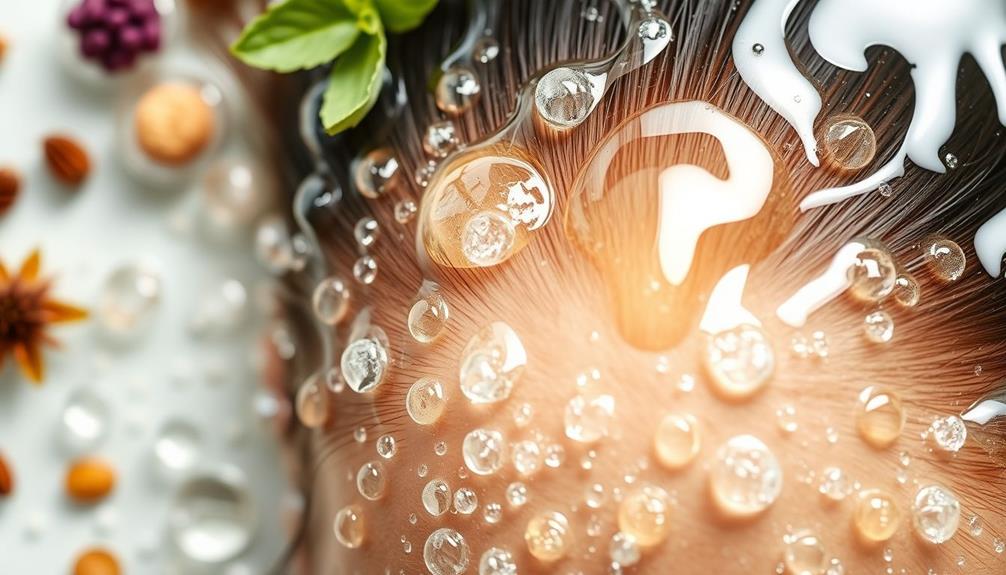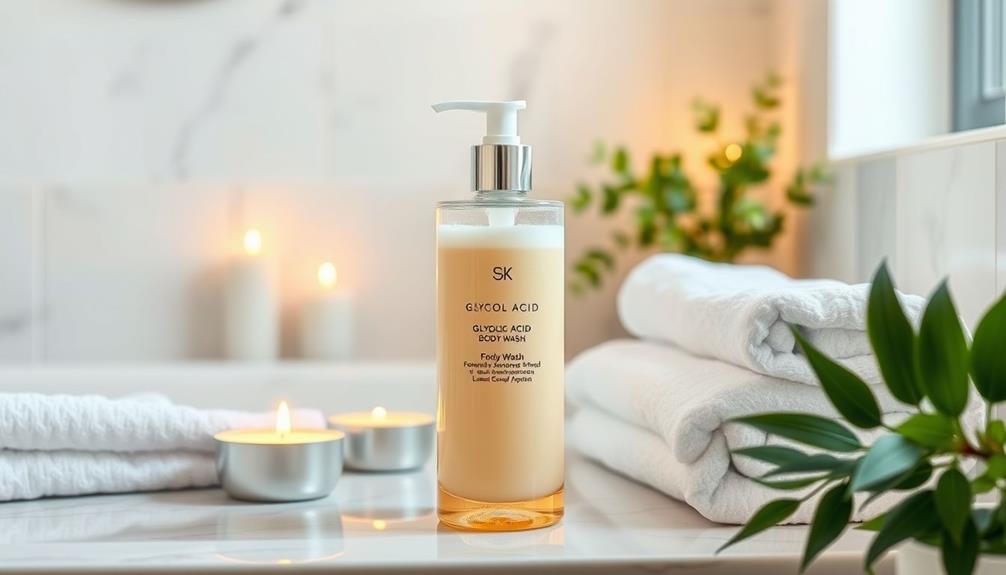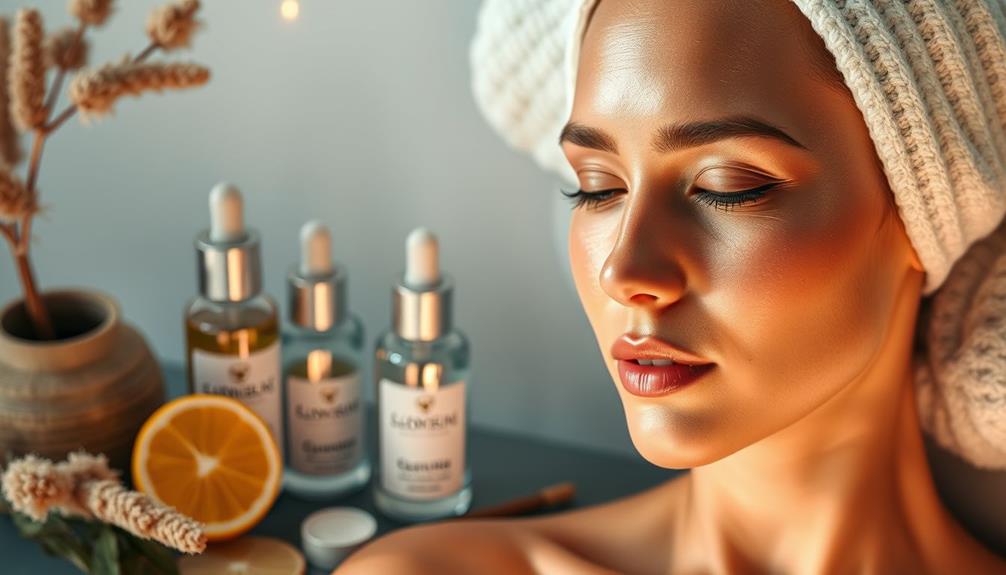Glycolic acid is transforming scalp care by providing potent exfoliation and hydration that create an ideal environment for healthy hair growth. It efficiently eliminates dead skin cells, minimizes product buildup, and unclogs hair follicles, resulting in a revitalized scalp. You will experience enhanced moisture retention, which helps combat dryness and flakiness while boosting hair strength and shine. Additionally, it preserves the balance of the scalp microbiome, preventing problems like dandruff. Whether you struggle with oily scalp or lackluster hair, incorporating glycolic acid into your regimen can make a significant difference. There is still much more to discover about its benefits and uses.
Key Takeaways
- Glycolic acid exfoliates dead skin cells, promoting a healthier scalp environment and enhancing hair growth potential.
- It boosts moisture retention, reducing dryness and flakiness for a hydrated, balanced scalp.
- The acid maintains scalp microbiome balance, preventing conditions like dandruff and promoting beneficial microorganisms.
- Glycolic acid enhances hair strength and elasticity, reducing breakage and improving overall hair manageability.
What Is Glycolic Acid?

Glycolic acid is an alpha hydroxy acid (AHA) derived from sugarcane that's known for its powerful exfoliating properties, helping to promote cell turnover on your scalp.
This organic compound works by breaking down the bonds between dead skin cells, effectively exfoliating the scalp.
Additionally, maintaining a clean environment with an air purifier can enhance the effectiveness of glycolic acid treatments by reducing airborne allergens and pollutants that might irritate the scalp.
When included in hair care products, glycolic acid typically appears at concentrations ranging from 5% to 10%.
This concentration allows it to penetrate deeply into the hair shaft, enhancing moisture retention and overall scalp health.
Benefits for Scalp Health
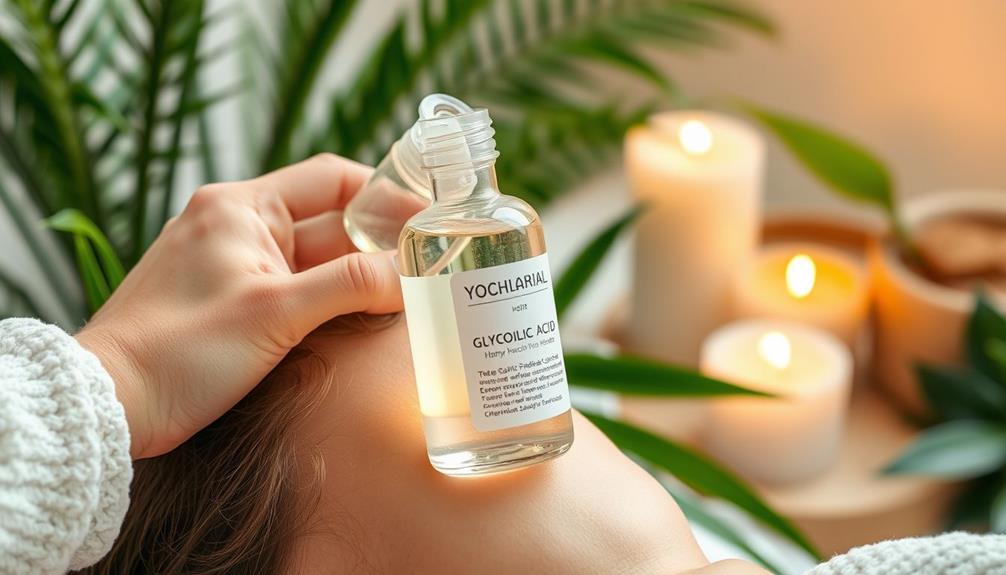
When you incorporate glycolic acid into your scalp care routine, you'll notice significant benefits for your scalp health.
It exfoliates dead skin cells, helping to renew the scalp while balancing moisture levels and supporting a healthy microbiome.
Additionally, combining glycolic acid with essential oils for hair growth can further enhance hair follicle stimulation and nourish your hair strands.
This combination not only promotes a cleaner scalp but also sets the stage for stronger, shinier hair.
Exfoliation and Renewal
Exfoliating the scalp with glycolic acid sheds dead skin cells, creating a healthier environment for hair growth. This powerful exfoliator helps improve the overall health of the scalp by removing excess sebum and product buildup. As a result, you'll notice reduced oiliness and enhanced scalp condition, which is essential for hair vitality.
Regular use of glycolic acid not only unclogs hair follicles but also reduces inflammation, promoting ideal hair retention. Clinical studies show that incorporating this ingredient into your scalp care routine leads to increased hair shine and overall vitality.
Here's a quick overview of the benefits of glycolic acid for scalp health:
| Benefit | Description |
|---|---|
| Shed Dead Skin Cells | Promotes a cleaner scalp for better hair growth. |
| Remove Product Buildup | Reduces oiliness and improves scalp condition. |
| Unclogs Hair Follicles | Enhances hair retention and reduces inflammation. |
Moisture Retention
Moisture retention plays an important role in scalp health, and incorporating glycolic acid into your routine can greatly enhance hydration levels. Glycolic acid works by stimulating the production of hyaluronic acid, a key molecule that helps maintain moisture in your scalp.
This boost in hydration is essential for creating a healthy environment for hair growth, much like how essential oils can support immune function through their antimicrobial properties.
When you regularly apply glycolic acid, you'll notice improved moisture retention within your scalp, which can markedly reduce common issues like dryness and flakiness. These problems often hinder healthy hair development, but with enhanced hydration, you'll see a more vibrant scalp and, consequently, healthier hair.
Additionally, glycolic acid penetrates deep into the scalp, ensuring long-lasting moisture retention that supports overall scalp wellness. This deeper hydration not only helps to strengthen hair strands, reducing breakage but also promotes smoother, shinier locks.
Scalp Microbiome Balance
Glycolic acid plays a key role in maintaining a balanced scalp microbiome, promoting overall scalp health and enhancing hair growth. By exfoliating dead skin cells, it prevents the overgrowth of harmful bacteria and fungi that can lead to various scalp issues.
When you incorporate glycolic acid into your scalp care routine, you're not just cleansing; you're also fostering a healthy environment for beneficial microorganisms. This balance is crucial for reducing conditions like dandruff and seborrheic dermatitis, which often arise from product buildup and lack of proper scalp hygiene.
Additionally, using hair treatments for damaged hair can complement the effects of glycolic acid, further promoting a healthy scalp.
Moreover, glycolic acid effectively removes excess sebum and residue from styling products, allowing your scalp's natural flora to thrive. This creates an ideal ecosystem where healthy hair can grow.
With improved scalp health and microbiome balance, you may notice stronger, healthier hair strands and a significant reduction in irritation and inflammation.
Incorporating glycolic acid into your scalp care treatments can be a game changer, ensuring your scalp remains healthy and conducive to hair growth. Prioritizing your scalp microbiome balance is crucial for achieving the hair health you desire.
Mechanism of Action
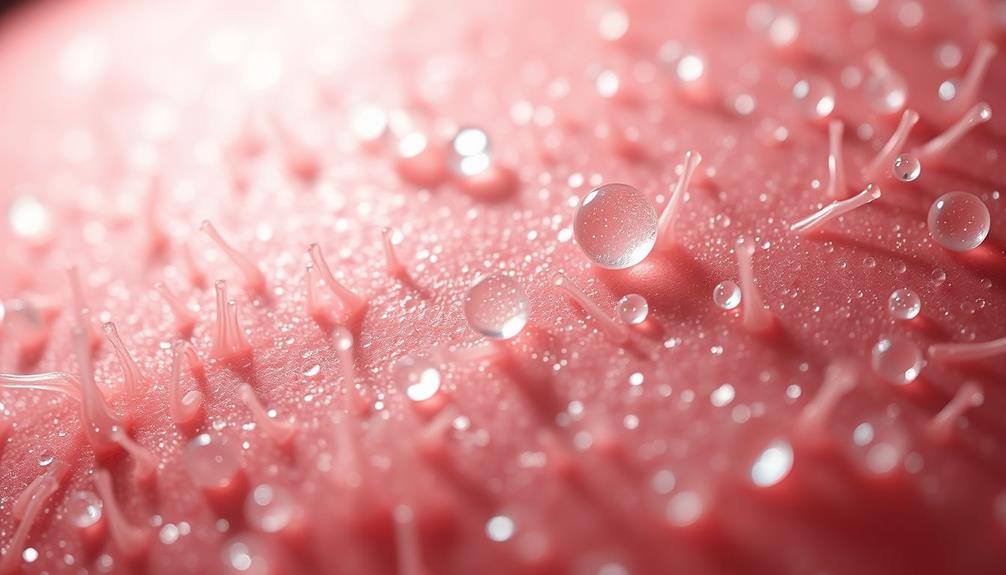
When you use glycolic acid, you're tapping into its powerful mechanism of action that enhances scalp care.
It penetrates deeply to exfoliate dead skin cells, promoting a sense of body awareness that parallels techniques found in self-exploration through body awareness.
This renewal not only strengthens your hair structure but also encourages emotional well-being, creating a holistic approach to hair care.
This combination not only promotes healthier hair growth but also improves texture and manageability.
Penetration and Absorption
Thanks to its small molecular size, glycolic acid penetrates deep into the hair shaft, enhancing both scalp and hair health effectively. This unique ability allows it to break down the bonds between dead skin cells on the scalp, promoting cell turnover. As a result, you'll notice healthier hair follicles and improved hair quality.
Glycolic acid also enhances the absorption of other beneficial ingredients in your hair products. By improving moisture retention within the hair structure, it guarantees that your hair stays hydrated and resilient. Scientific studies have shown that treatments with glycolic acid can increase elasticity and reduce breakage, making your hair stronger and more manageable.
Here's a quick comparison to illustrate the benefits of glycolic acid in hair care:
| Aspect | Glycolic Acid |
|---|---|
| Molecular Size | Small |
| Penetration Depth | Deep into hair shaft |
| Cell Turnover | Promotes |
| Moisture Retention | Enhanced |
| Hair Elasticity | Increased |
With its remarkable penetration and absorption capabilities, glycolic acid is truly a game-changer in scalp and hair care.
Exfoliation and Cell Renewal
Exfoliation with glycolic acid effectively breaks down the bonds between dead skin cells on the scalp, promoting cell renewal and creating a healthier environment for hair growth. By utilizing its small molecular size, glycolic acid penetrates deeply, facilitating effective exfoliation and enhancing cell turnover.
This process helps remove dead cells that can clog hair follicles, which is essential for maintaining a balanced scalp environment. Additionally, embracing natural ingredients in your hair care routine can complement the benefits of glycolic acid, ensuring overall scalp health and balance.
Unique experiences await as you explore how different products can impact your scalp health.
As you incorporate glycolic acid into your routine, you'll notice how it helps reduce product buildup and excess sebum, both of which can hinder healthy hair growth. Regular use not only stimulates cellular renewal but also supports moisture retention, leading to improved overall scalp health.
With consistent application, you'll find that the exfoliating properties of glycolic acid can considerably enhance the condition of your scalp.
Clinical studies back this up, showing that those who use glycolic acid treatments see marked improvements in scalp conditions. Ultimately, this results in stronger hair strands and reduced breakage.
Strengthening Hair Structure
Glycolic acid works by penetrating the hair shaft, altering its internal structure to enhance moisture retention and flexibility, which ultimately strengthens your hair. This powerful ingredient helps reduce brittleness and dryness by promoting cell turnover and unclogging hair follicles. As a result, you're not just improving the surface of your hair but reinforcing it from the root.
Research indicates that glycolic acid considerably decreases Young's modulus, enhancing hair elasticity and reducing breakage. This means your hair can endure more without snapping, giving you stronger strands. Additionally, glycolic acid increases the denaturing temperature of healthy hair by approximately 10°C, indicating improved thermal stability.
Moreover, glycolic acid helps facilitate the absorption of other beneficial ingredients, amplifying the effects of your hair care products. By breaking down product buildup, it allows nutrients to penetrate deeper, further enhancing your hair's health.
Ideal Hair Types

For those with oily or flaky scalps, incorporating glycolic acid into your hair care routine can lead to clearer, healthier skin. Glycolic acid effectively exfoliates dead skin cells, reducing excess sebum production and promoting a balanced scalp environment. This makes it particularly beneficial for specific hair types.
If you're considering adding glycolic acid to your routine, here are some ideal hair types to keep in mind:
- Oily or Flaky Scalps: It helps manage oiliness and flakiness effectively.
- Normal to Combination Hair: It maintains scalp health without over-drying, providing a balanced approach.
While glycolic acid can work wonders, be cautious with long-term use. Excessive application could weaken your hair and potentially lead to hair loss.
Additionally, if your hair is color-treated or recently chemically treated, it's best to avoid glycolic acid to prevent damage. Understanding your hair type will help you make the most of your scalp care routine.
How to Use Effectively
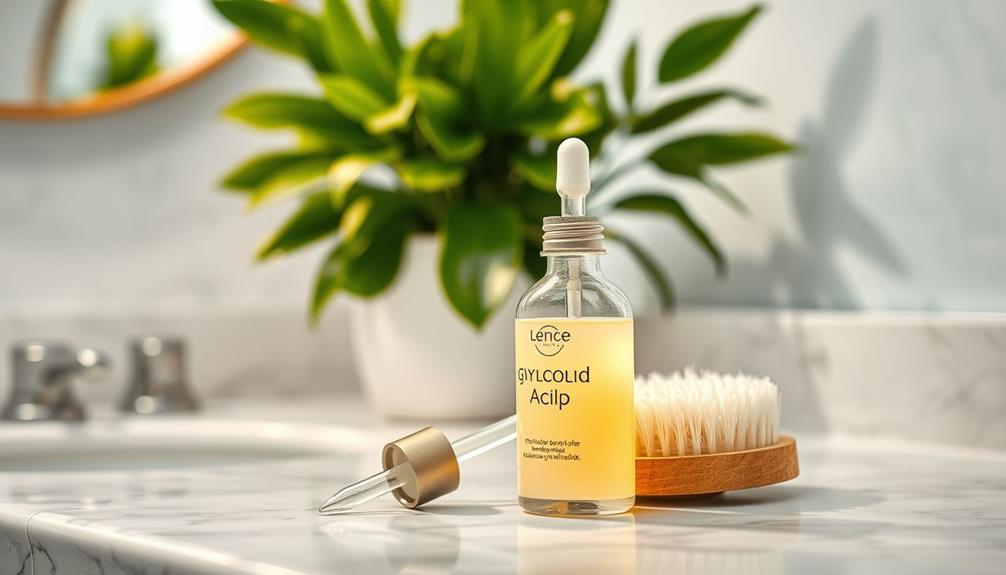
To effectively incorporate glycolic acid into your scalp care routine, apply treatments once or twice a week to avoid irritation while promoting healthy exfoliation.
Begin by shaking the product well to guarantee the acid is evenly mixed. Use the nozzle to target your scalp directly, allowing for even distribution and best results.
Once applied, leave the treatment on for about 10 minutes. This duration is essential for the glycolic acid to work its magic, effectively exfoliating dead skin cells and breaking down product buildup.
For enhanced results, consider using a scalp massager during application. This not only stimulates circulation but also improves product penetration, maximizing the benefits of the acid.
After the treatment, always follow up with a gentle shampoo and conditioner. This step helps maintain moisture balance and protects your scalp post-exfoliation.
By incorporating glycolic acid products in this manner, you can achieve a healthier, rejuvenated scalp, promoting overall hair health without the drawbacks of overuse.
Stick to this routine, and you'll notice a significant improvement in scalp health and hair appearance.
Safety Precautions

When using glycolic acid, it's important to be aware of safety precautions to protect your scalp and avoid irritation. Although this ingredient can work wonders, improper use may lead to adverse reactions. Here are some key safety precautions to keep in mind:
- Patch Testing: Always perform a patch test before applying glycolic acid to your scalp. This helps identify any potential adverse reactions, especially if you're new to this ingredient.
- Frequency of Use: Limit your application to 1-2 times per week. Over-exfoliating can cause dryness and irritation, undermining the benefits of glycolic acid.
Always discontinue use if you experience any irritation or adverse reactions. If specific scalp concerns arise, consult with a dermatologist for personalized advice.
Clinical Evidence
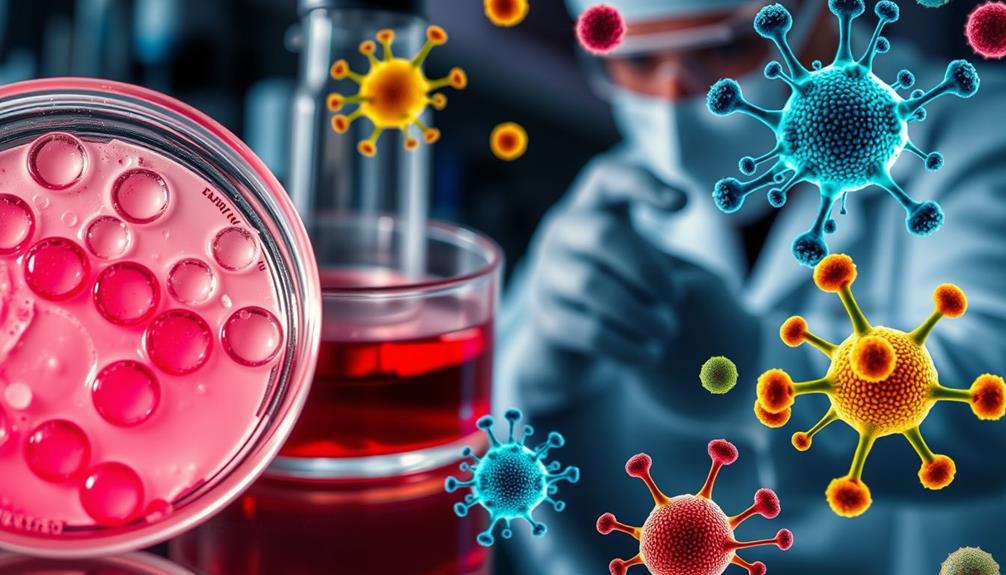
Numerous clinical studies confirm that glycolic acid not only effectively exfoliates the scalp but also enhances hair health by improving moisture retention and elasticity.
Research shows that glycolic acid treatment markedly boosts hair moisturization, making your locks softer and more manageable. This results in reduced breakage rates, allowing for healthier hair growth.
Experiments utilizing differential scanning calorimetry have revealed that glycolic acid penetrates hair fibers, leading to structural changes that enhance overall strength.
You'll also find that regular use helps reduce excess sebum production and product buildup, creating a healthier scalp environment that's conducive to hair growth.
The clinical evidence supporting glycolic acid's efficacy in scalp care is robust, with numerous studies reinforcing its role as an essential ingredient in hair treatment formulations.
By incorporating glycolic acid into your hair care routine, you're not just exfoliating your scalp but also actively promoting better hair health.
With consistent use, you can expect a noticeable improvement in moisture levels and elasticity, making glycolic acid a powerful ally in your quest for luscious, healthy hair.
Market Trends and Innovations
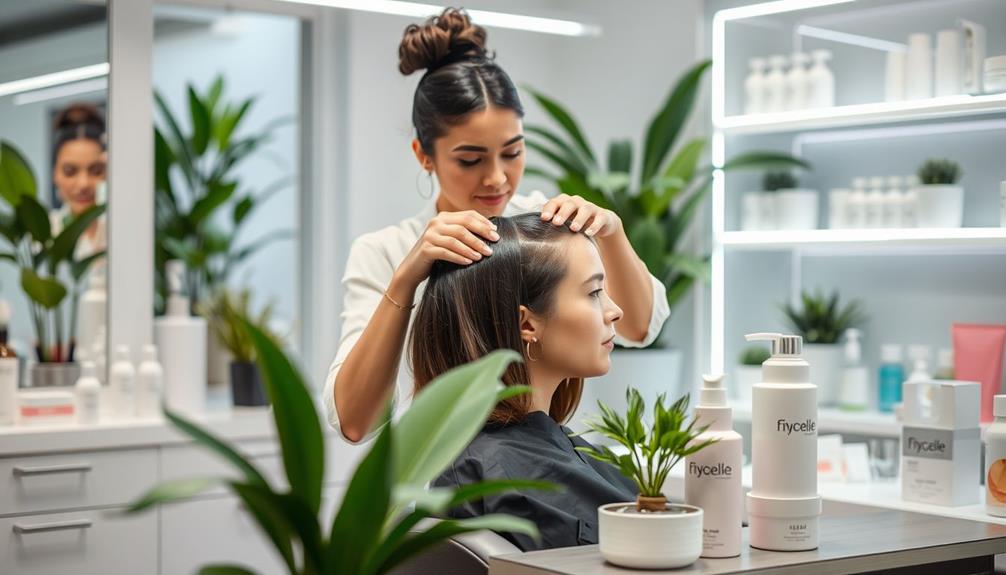
Recognizing the growing demand for effective scalp care, brands are increasingly incorporating glycolic acid into their product lines to meet consumer expectations for both exfoliation and hydration. This ingredient is gaining traction in the hair care industry, driven by its proven benefits for scalp health and its versatility in formulations.
Here are a few market trends and innovations you should know about:
- Natural Ingredients: Many brands are focusing on clean beauty, blending glycolic acid with organic components for gentle yet effective scalp treatments.
- Targeted Solutions: Products are now specifically designed to address common scalp issues like dandruff and excessive oiliness, showcasing glycolic acid's dual role as an exfoliant and moisturizer.
This evolution reflects a broader shift in hair care, as consumers seek effective solutions that prioritize both scalp wellness and hair health. Glycolic acid is at the forefront of this movement, revolutionizing how we approach scalp care.
Frequently Asked Questions
What Happens if You Put Glycolic Acid on Your Scalp?
When you apply glycolic acid to your scalp, it helps exfoliate dead skin, unclogs hair follicles, and reduces buildup. You'll notice a healthier scalp, improved moisture retention, and potentially stronger, less breakable hair.
Does Glycolic Acid Get Rid of Scalp Buildup?
Yes, glycolic acid effectively gets rid of scalp buildup. It exfoliates by dissolving dead skin cells and product residue, promoting a healthier scalp and allowing for better absorption of your hair care products.
Is Glycolic Acid Good for Seborrheic Dermatitis on Scalp?
Studies show glycolic acid can reduce scalp flakiness by up to 50%. If you're struggling with seborrheic dermatitis, using it 1-2 times weekly may alleviate irritation and promote a healthier, more comfortable scalp.
What Is the Effect of Using Glycolic Acid in Hair Care Products?
Using glycolic acid in hair care products strengthens your hair, reduces breakage and split ends, and improves moisture retention. It also exfoliates your scalp, promoting healthier conditions and enhancing the overall softness and shine of your hair.
Conclusion
Incorporating glycolic acid into your scalp care routine can be a game changer for healthier hair.
Just like the saying goes, "A stitch in time saves nine," taking proactive steps now can prevent future scalp issues.
By understanding its benefits and how to use it effectively, you can revitalize your scalp and enhance your hair's overall appearance.
Embrace this innovation and watch your hair thrive!
Your scalp deserves the best, so why wait?

